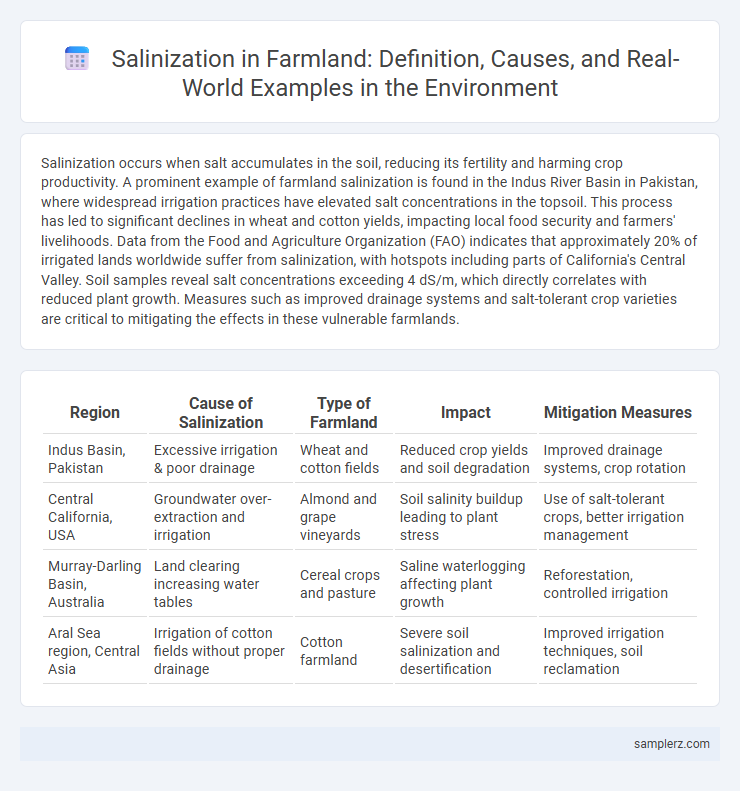Salinization occurs when salt accumulates in the soil, reducing its fertility and harming crop productivity. A prominent example of farmland salinization is found in the Indus River Basin in Pakistan, where widespread irrigation practices have elevated salt concentrations in the topsoil. This process has led to significant declines in wheat and cotton yields, impacting local food security and farmers' livelihoods. Data from the Food and Agriculture Organization (FAO) indicates that approximately 20% of irrigated lands worldwide suffer from salinization, with hotspots including parts of California's Central Valley. Soil samples reveal salt concentrations exceeding 4 dS/m, which directly correlates with reduced plant growth. Measures such as improved drainage systems and salt-tolerant crop varieties are critical to mitigating the effects in these vulnerable farmlands.
Table of Comparison
| Region | Cause of Salinization | Type of Farmland | Impact | Mitigation Measures |
|---|---|---|---|---|
| Indus Basin, Pakistan | Excessive irrigation & poor drainage | Wheat and cotton fields | Reduced crop yields and soil degradation | Improved drainage systems, crop rotation |
| Central California, USA | Groundwater over-extraction and irrigation | Almond and grape vineyards | Soil salinity buildup leading to plant stress | Use of salt-tolerant crops, better irrigation management |
| Murray-Darling Basin, Australia | Land clearing increasing water tables | Cereal crops and pasture | Saline waterlogging affecting plant growth | Reforestation, controlled irrigation |
| Aral Sea region, Central Asia | Irrigation of cotton fields without proper drainage | Cotton farmland | Severe soil salinization and desertification | Improved irrigation techniques, soil reclamation |
Causes of Salinization in Agricultural Land
Irrigation with saline water and poor drainage systems contribute significantly to salinization in agricultural land, as excess water evaporates and leaves salts behind. Overuse of chemical fertilizers also increases soil salinity by altering the natural mineral balance. Natural factors such as high evaporation rates in arid and semi-arid regions further exacerbate salt accumulation in farmland soils.
Key Regions Affected by Farmland Salinization
Farmland salinization primarily affects key regions such as the Indus Basin in Pakistan, the Central Valley in California, and the Murray-Darling Basin in Australia, where excessive irrigation and poor drainage lead to salt accumulation in the soil. In these areas, high evaporation rates and low rainfall exacerbate salt concentration, reducing soil fertility and crop yields. Effective management practices like improved irrigation techniques and soil reclamation are critical to mitigating salinization impacts in these vulnerable agricultural zones.
Case Study: Salinity in the Indo-Gangetic Plains
The Indo-Gangetic Plains have experienced significant soil salinization, primarily due to intensive irrigation practices that raise the water table and bring dissolved salts to the surface. This phenomenon reduces agricultural productivity by impairing soil structure and limiting crop growth, particularly affecting staple crops like wheat and rice. Mitigation strategies involve improved drainage systems, salt-tolerant crop varieties, and regulated irrigation to restore soil health and sustain farming livelihoods in the region.
Irrigation Practices Leading to Soil Salinization
Excessive irrigation with poor drainage in arid and semi-arid regions causes the accumulation of salts in the root zone, leading to soil salinization that reduces crop yield and soil fertility. For instance, the Indus Basin in Pakistan faces severe salinization due to continuous canal irrigation without adequate leaching, disrupting agricultural productivity. Implementing efficient irrigation methods like drip irrigation and improving drainage infrastructure is critical to mitigating salinization impacts on farmland.
Impact of Salinization on Crop Yield
Salinization significantly reduces crop yield by increasing soil salinity levels, which disrupts water uptake and nutrient absorption in plants. For example, in California's Central Valley, the accumulation of salts in irrigated farmland has led to a decline in cotton and tomato production by up to 30%. High salinity stress causes osmotic imbalance and ion toxicity, resulting in stunted growth and lower agricultural productivity.
Notable Examples: Salinization in California’s Central Valley
California's Central Valley faces severe salinization due to intensive irrigation combined with poor drainage, causing accumulation of salts in the soil. This salinization reduces crop yields and soil fertility, impacting key agricultural commodities like almonds, cotton, and rice. Efforts to manage salinity include improved irrigation practices, salt-tolerant crop varieties, and drainage system enhancements to protect this vital farmland from further degradation.
Management and Remediation Techniques for Saline Soils
Management of saline soils often involves the application of gypsum to displace sodium ions and improve soil structure, enhancing water infiltration. Leaching with high-quality irrigation water effectively reduces salt concentration, while planting salt-tolerant crops like barley or quinoa aids in maintaining productivity under saline conditions. Integrated drainage systems are critical for preventing waterlogging and salt accumulation, ensuring sustainable farmland use.
Economic Consequences of Farmland Salinization
Salinization of farmland causes significant economic losses by reducing crop yields and increasing the costs of soil reclamation and water management. In countries like Pakistan, approximately 2.1 million hectares of irrigated land are affected, resulting in annual losses exceeding $1 billion due to decreased agricultural productivity. These financial impacts threaten rural livelihoods, food security, and national economies reliant on agriculture.
Farmer Adaptations to Salinized Farmland
Farmers in salinized farmland areas often implement salt-tolerant crop varieties and improved irrigation techniques such as drip irrigation to reduce soil salinity. Soil reclamation methods, including gypsum application and organic matter addition, help restore fertility and enhance water infiltration. Crop rotation with salt-resistant plants like barley and quinoa supports sustainable agricultural productivity under salinity stress.
Future Outlook: Preventing Salinization in Agriculture
Implementing advanced irrigation technologies and promoting crop rotation with salt-tolerant species can significantly reduce the risk of salinization in farmland. Precision agriculture techniques, combined with real-time soil monitoring, enable early detection and management of saline conditions. Investing in sustainable water management practices ensures long-term soil health and agricultural productivity amidst increasing environmental challenges.

example of salinization in farmland Infographic
 samplerz.com
samplerz.com